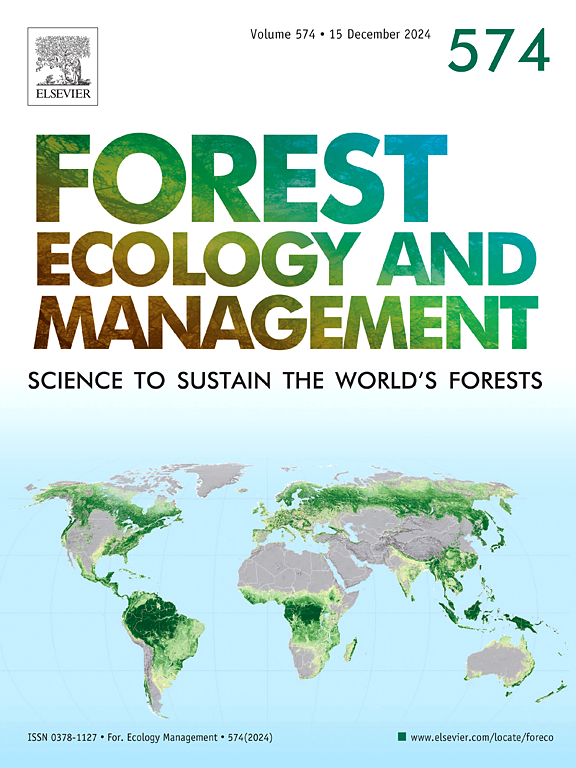阿巴拉契亚阔叶林带状砍伐对自然北方红橡树繁殖的10年响应
IF 3.7
2区 农林科学
Q1 FORESTRY
引用次数: 0
摘要
众所周知,在整个中部硬木地区,橡树林的再生存在困难。为了成功地使橡树再生,在收获之前需要有竞争性的先进繁殖资源,这种情况很少出现,特别是在生产场所。虽然有提高幼苗竞争力的处理方法(例如,中层清除、焚烧、竞争性植被控制),但在实践中,由于处理成本高和/或需要延迟收获,这些方法很少得到实施和/或有效。作为一种潜在的替代实践,我们报告了一种条带清除繁殖方法的10年结果,该方法在阿巴拉契亚混合阔叶林中交替去除45.7 m宽的条带,其中最初采伐的条带提供木材收入,同时提高下层光照水平,以增加剩余条带内橡树幼苗的大小,从而增加未来采伐中橡树的存在。10 年之后,我们发现伐带有利于北方红橡树在剩余伐带内的超前繁殖。北红橡树幼苗密度(1万茎/公顷)高于其他树种。北方红橡树幼苗在残留带内11.4 m位置竞争最激烈,而沿残留带边缘竞争的北方红橡树幼苗密度高也与竞争的黑桦树(Betula lenta L.)和黑樱桃树(Prunus sertina Ehrh.)繁殖有关。采伐带中以黑桦树和黄杨(Liriodendron tulipifera L.)为优势茎,几乎不存在栎树。本文章由计算机程序翻译,如有差异,请以英文原文为准。
The 10-year response of natural northern red oak reproduction to strip clearcutting an Appalachian hardwood stand
There are well-known difficulties associated with regenerating oak stands throughout the Central Hardwoods region. To successfully regenerate oak, competitive sources of advance reproduction are required ahead of harvesting—a condition that is rarely present, especially on productive sites. While treatments that enhance seedling competitiveness (e.g., midstory removals, burning, competing vegetation control) are available, in practice, these are rarely implemented and/or effective because of high treatment costs and/or because they require delaying harvest.
As a potential alternative practice, we report the 10-yr results of a strip clearcut reproduction method that removes alternating 45.7 m wide strips across a mixed Appalachian hardwood forest, where the initial harvested strips provide timber revenue while simultaneously elevating understory light levels to increase oak seedling size within the residual strips to increase oak presence in a future harvest.
After 10 yr, we found that strip clearcutting facilitated the development of competitive northern red oak (Quercus rubra L.) advance reproduction within the residual strips. Northern red oak seedling densities (>10,000 stems/ha) were greater than any other species. Northern red oak seedlings were most competitive within the interior 11.4 m positions in the residual strips, while the high densities of competitive northern red oak seedlings along the edges of the residual strips were also associated with competitive black birch (Betula lenta L.) and black cherry (Prunus serotina Ehrh.) reproduction. By contrast, in the cut strips, black birch and yellow-poplar (Liriodendron tulipifera L.) were the dominant stems and oaks were almost nonexistent.
求助全文
通过发布文献求助,成功后即可免费获取论文全文。
去求助
来源期刊

Forest Ecology and Management
农林科学-林学
CiteScore
7.50
自引率
10.80%
发文量
665
审稿时长
39 days
期刊介绍:
Forest Ecology and Management publishes scientific articles linking forest ecology with forest management, focusing on the application of biological, ecological and social knowledge to the management and conservation of plantations and natural forests. The scope of the journal includes all forest ecosystems of the world.
A peer-review process ensures the quality and international interest of the manuscripts accepted for publication. The journal encourages communication between scientists in disparate fields who share a common interest in ecology and forest management, bridging the gap between research workers and forest managers.
We encourage submission of papers that will have the strongest interest and value to the Journal''s international readership. Some key features of papers with strong interest include:
1. Clear connections between the ecology and management of forests;
2. Novel ideas or approaches to important challenges in forest ecology and management;
3. Studies that address a population of interest beyond the scale of single research sites, Three key points in the design of forest experiments, Forest Ecology and Management 255 (2008) 2022-2023);
4. Review Articles on timely, important topics. Authors are welcome to contact one of the editors to discuss the suitability of a potential review manuscript.
The Journal encourages proposals for special issues examining important areas of forest ecology and management. Potential guest editors should contact any of the Editors to begin discussions about topics, potential papers, and other details.
 求助内容:
求助内容: 应助结果提醒方式:
应助结果提醒方式:


